Liberal Arts Action Lab: Frog Hollow Storytelling Collaboration with SINA
In the Fall of 2021, I chose to apply to the Liberal Arts Action Lab. I had not heard a lot about it, other than that it took place at the Trinity campus downtown. There were four projects to choose from: community housing ownership, energy efficiency, neighborhood investment, and oral history. Personally, I have a strong interest in storytelling. Coming to Trinity, I also had the goal of getting to know the surrounding community and its history to better understand my place as a student at the College. Choosing the Frog Hollow oral history project seemed like the perfect culmination of my goals and interests. I also had never participated in research at Trinity College, so this seemed like an ideal way to dip my toe in the water. Over the course of the semester, I not only learned about research methods, but also forged connections outside of the fence of Trinity College that made me feel like a neighbor in the Frog Hollow community.
This project has made me feel more connected to the community. Through the power of storytelling, I feel like a neighbor now. I can walk through the neighborhood knowing the voices and stories inside the buildings, and feel confident to now share with others in the Trinity community why Frog Hollow is important and how it is a great part of the Trinity experience to engage with.
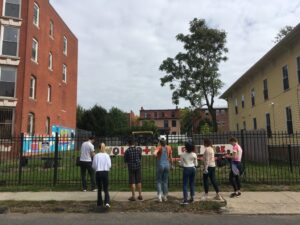
Each Action Lab group worked with a community partner on a question the community partner had proposed. The Frog Hollow Storytelling group worked with the Hartford community organization SINA (Southside Institutions Neighborhood Alliance). SINA asked the Action Lab: “What are the stories of the people in the Frog Hollow neighborhood from first-hand knowledge?” Their aim is to create a walking tour app from the information we collected. The aim of a walking tour app, is to tell outsiders, and reaffirm to Frog Hollow community members, that what is here matters: there are stories to be told, voices to uplift, heroes and projects to be celebrated. Visitors could come to Frog Hollow and foster more empathy, rather than project unjust assumptions. Neighbors can take the tour and have more of an understanding of the history, and feel pride in the community.
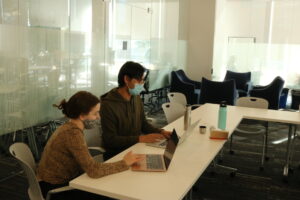
In the Action Lab, we attended two courses: a research methods course, and a course to work on our project. In the methods course, taught by Dr. Emily Cummins, and the project course, taught by Dr. Camilo Ruiz-Sanchez, we learned about ethical research, methodology, and our positionality as Trinity College student researchers. With this information, we moved forward in our project groups with a toolbox of ways to conduct research, in a way that is reflexive and promotes social change. Mixed methods, participatory action research, positionality, and reflexivity, all became part of our vocabulary and practice of research. From there, we prepared our plan of action for research, making sure to discuss each choice carefully based on what we had learned.
The research process was a journey. We met with Logan Singerman, director of community partnerships and communications at SINA. He was a great community partner, as he had so much knowledge about Frog Hollow. He also had connections with and stories about many community members. Our most common research methodology for collecting stories was the snowball method, where from one connection, we asked about or received more. Our job as the student researchers was not to create the walking tour app but to create the foundation for it by creating a digital archive to act as the script for the app.
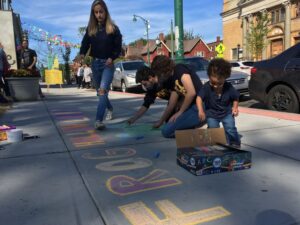 We began our process by learning about SINA with Logan. We visited the Hartford History Center and the Watkinson at Trinity College, to look through newspaper archives about Frog Hollow. Documenting the newspapers, we assessed common places and people who came up to incorporate into the script and to ask community members about in later interviews. We took walking tours ourselves about history, led by Logan, and public art, led by muralist Lindaluz Carillo. During this fieldwork, we took notes in our own research logbooks, recorded audio, and photographed. The logbooks were important throughout the process for reflecting on our research and field experiences, in order to maintain reflexivity and keep the conception of our positionality in check, as well as to process any moments with high emotions. We attended community events, like the inaugural opening of the new Park Street Library branch at the Lyric, and the mural unveiling of Frog Hollow heroes, another project by SINA. Reflecting on these fieldwork opportunities and interactions, Joshua Jacoves, another student in the group, expressed, “I really valued my time at the Action Lab. Coming into Trinity I really wanted to be able to leave campus and learn from the community. I felt that the Action Lab gave me the opportunity to work with Hartford in a way I wouldn’t be able to in a Trinity classroom.”
We began our process by learning about SINA with Logan. We visited the Hartford History Center and the Watkinson at Trinity College, to look through newspaper archives about Frog Hollow. Documenting the newspapers, we assessed common places and people who came up to incorporate into the script and to ask community members about in later interviews. We took walking tours ourselves about history, led by Logan, and public art, led by muralist Lindaluz Carillo. During this fieldwork, we took notes in our own research logbooks, recorded audio, and photographed. The logbooks were important throughout the process for reflecting on our research and field experiences, in order to maintain reflexivity and keep the conception of our positionality in check, as well as to process any moments with high emotions. We attended community events, like the inaugural opening of the new Park Street Library branch at the Lyric, and the mural unveiling of Frog Hollow heroes, another project by SINA. Reflecting on these fieldwork opportunities and interactions, Joshua Jacoves, another student in the group, expressed, “I really valued my time at the Action Lab. Coming into Trinity I really wanted to be able to leave campus and learn from the community. I felt that the Action Lab gave me the opportunity to work with Hartford in a way I wouldn’t be able to in a Trinity classroom.”
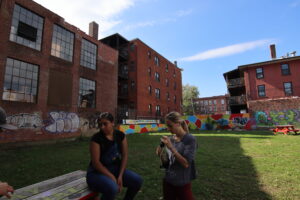
The Park Street Library opening was one of my favorite fieldwork outings and part of capturing the essence of Frog Hollow. This was the turning point for me in the project in understanding the essence of Frog Hollow, more through the eyes of the community members. I felt a hum of energy from the community that I was unable to feel before, or at other fieldwork outings. There were hundreds of people outside of the library, and parading down the street. It was the most celebratory library event I have ever been to, with festive music and cheering. From the speakers and the showmanship and the energy, I could tell that this was more than a library – it was a movement; it was community solidarity. The Frog Hollow community, though, has helped me understand how radical a library can be for neighborhoods like Frog Hollow, whose community members often are put at odds due to societal and economic systems.
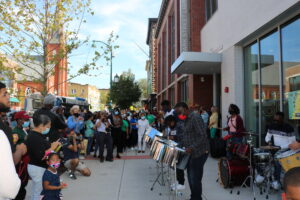
Throughout the process of creating our own archive, we realized there are many archives or resources already in Frog Hollow, documenting its stories and people. Since there was so much already documented in the community, we discovered that we could work with these existing archives, and bring them together into one platform.
The archive we created is divided into several “lines,” to allow several paths to follow in the eventual walking tour app. Specifically, the archive focuses on community spaces, public art, voices of Frog Hollow, and heroes of Frog Hollow. SINA’s Heroes of Frog Hollow mural project allowed us to incorporate the stories of the nine heroes voted on by the community through SINA, to be painted into public murals in Frog Hollow. There were over 30 nominations for the nine heroes, and we decided to create a voices of Frog Hollow section, recognizing the many other heroes who weren’t selected for the murals. This was the theme I worked on with another student, Catherine Doyle.
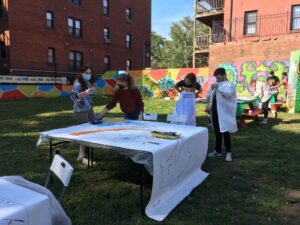
Another project we incorporated into this section was the Voices of Frog Hollow video project by Nygel White and Graciela Rivera, who work at the Hartford Public Library. This project was their brainchild in the Summer of 2021, highlighting businesses on Park Street, and the voices behind them. We interviewed White and Rivera about their process. Another public archive we integrated is the Puerto Rican Heritage Trail, which Carol Correa, Trinity’s Director of the Office of Multicultural Affairs, created during her time as a graduate student at the College. The point of interviewing the creators of these projects was not only to hear about their own research process but also their experience in Frog Hollow. People like Rivera and Leticia Cotto, another important community member who works at the Hartford Public Library, were interviewed to speak about voices of Frog Hollow who have passed away, like Celestino Jimenez.
The connections we made with one interview led us to another interview or deepened insights that we took into subsequent interviews, proving the interconnectivity and strength of the Frog Hollow community. Leticia Cotto invited us to her home to share dinner with some women and their children who are recent Guatemalan immigrants. Cotto wanted us to uplift these voices, and this new community and story shaping Frog Hollow.
Going to Leticia’s home to share dinner with some of Frog Hollow’s Guatemalan immigrant community was probably the most intense and impactful fieldwork of this project. It felt like a great culmination of the project, where our connections to Leticia Cotto, and her trust in us, allowed for this opportunity. Leticia’s input also helped us realize and empower a new community and different voice than what we had been capturing. I do not think that any of us in the project group anticipated the trajectory and bandwidth of making connections through this process of interviewing. The process proved to be non-linear and the interconnectivity of the Frog Hollow neighborhood. I had the most emotional reaction to this experience, and I think the interviewees did too. Another student in my group, Sophie Sczurko, who attended Leticia’s home, shared, “I’ve had the opportunity to work with so many amazing individuals and I can’t wait to continue my relationship with them throughout my Trinity career.”
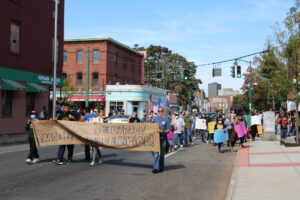
The project was dynamic and collaborative, showing the flexible and spontaneous nature of research and oral history. Many of us jumped into interviews for other lines and took photos for each other. I interviewed the Reverend of Templo Fe down the street from Trinity. I was not learning just about the voices, but about the community spaces and organizations as well.
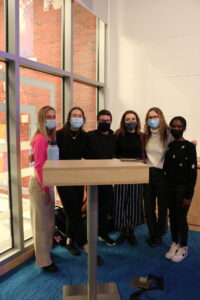
Throughout the project, we compiled our data on a spreadsheet, which then was translated onto an Omeka site, which is a platform for curating digital archives. There is also a map on the site, to simulate the walking tour that is to come this spring. We presented our digital archive at the new Park Street Library at the Lyric, proving the full-circle nature of our project. This felt impactful as this archive was supposed to be for the Frog Hollow community themselves, and they truly shaped it and made it what it is. The food was catered by the Guatemalan women whom we interviewed and paid them with our research stipend. There was a great community turnout, and Professor Ruiz helped us make it more accessible with Spanish translation. We also presented at a poster fair with the rest of the project groups at the Action Lab. Before our project presentation, Kristina Kendall, an Action Lab student also in the Frog Hollow storytelling project, reflected, “I liked learning about the community that we don’t traditionally interact with. It was very fulfilling.”
While the semester is over, I will continue to engage with this project for the rest of my college career, informing my choices of how I interact with others and move around in the contrasting spaces of Trinity College in Frog Hollow, allowing Trinity’s fences to dissolve.
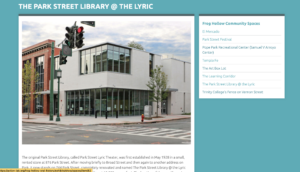
This project has made me feel more connected to the community. Through the power of storytelling, I feel like a neighbor now. I can walk through the neighborhood knowing the voices and stories inside the buildings, and feel confident to now share with others in the Trinity community why Frog Hollow is important and how it is a great part of the Trinity experience to engage with. I hope to continue my connections with the people and spaces I have interacted with. While the semester is over, I will continue to engage with this project for the rest of my college career, informing my choices of how I interact with others and move around in the contrasting spaces of Trinity College in Frog Hollow, allowing Trinity’s fences to dissolve.
